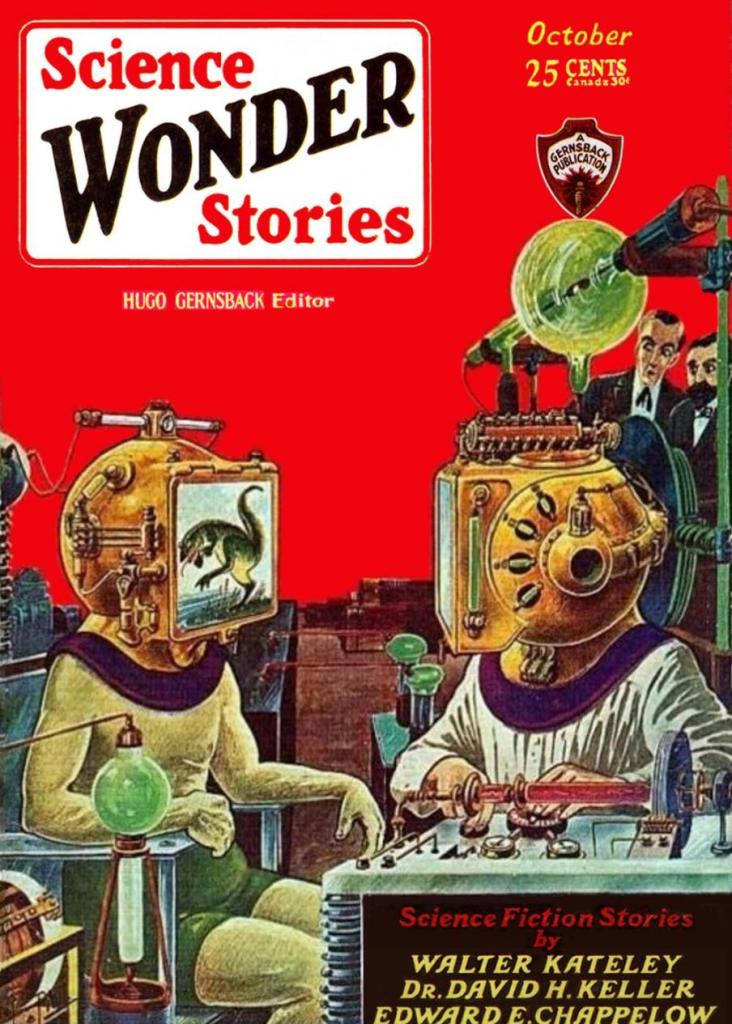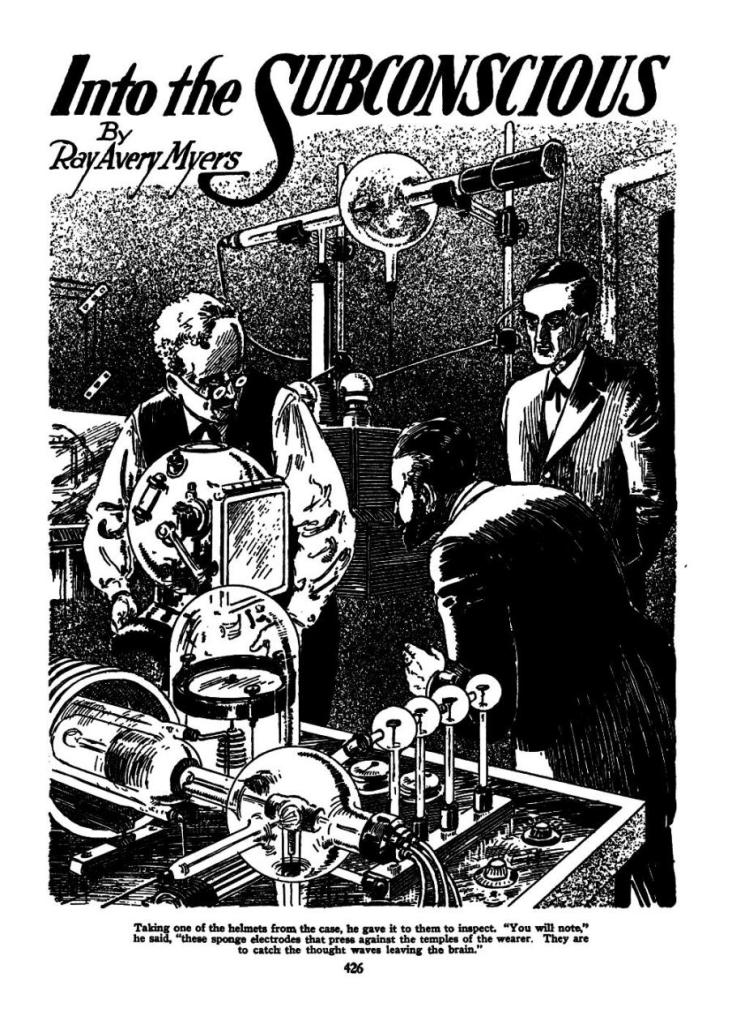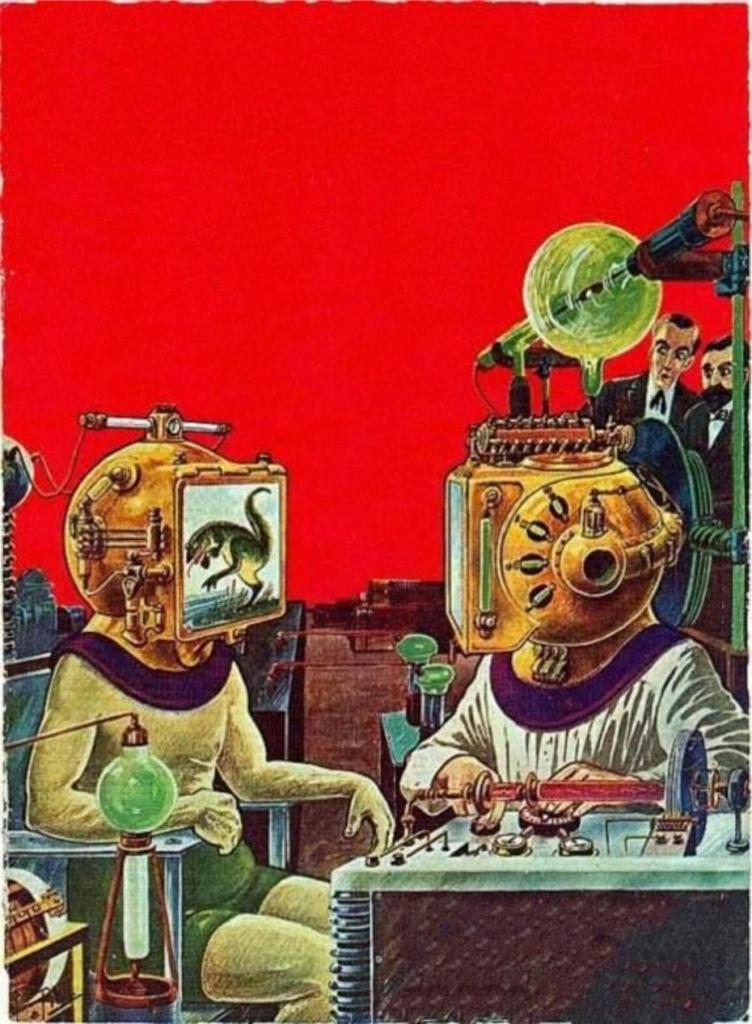
It’s surprising how often you see this cover on the internet. It’s even sold as a print, fridge magnet, and puzzle. I think the artwork is both ugly and bizarre. Why would people be wearing helmets with video screens for the faceplates? To find out why, I went and read “Into the Subconscious” by Ray Avery Myers, the cover story in the October 1929 issue of Science Wonder Stories. The explanation was bonkers.
Mad scientist Doc Macey has invented a way to view the past. I’ve always thought it would be fantastic if we could see the past, but I seriously doubt Doc Macey’s technique will ever work. He theorizes that humans have memories of all their past ancestors, including all the animal stages we’ve passed through in the history of evolution. I can see how Myers could think this up this idea for a science fiction story, but wouldn’t it involve too much information to transfer from generation to generation? Anyway, Doc Macey uses hypnotism and a special ray he discovered to read those memories and project them onto a screen. The story gets even crazier when he explains why different human body types are key to delving into specific animals in the past.

In the course of the experiment, his test subject remembers being a Neanderthal but eventually regressed to remembering being an amphibian during the time of the dinosaurs. We see that in the cover painting. You’d think this idea is too whacky for anyone to believe, but in the 1950s it was the basis of a bestselling “nonfiction” book, The Search for Bridey Murphy. The same idea was used for a 1965 Broadway play, On a Clear Day You Can See Forever, which was remade into a 1970 Barbra Streisand film of the same name. There is a rather long article on Wikipedia about past life regression.
Luckily, I believe such nonsense is no longer accepted even by kooks, but who knows. Still, I’m intrigued by Frank R. Paul’s cover showing people with video-screen faceplates. VR goggles, glasses, and helmets are a big thing right now, but their screens face the wearer. Why would a screen face outward so others can see? This got me thinking.
I watch a lot of YouTube videos. And to me, the best way to explain anything is to show a video. What if we developed a language based on videos? Instead of using words we just projected videos. Videos we recorded ourselves from our own experiences, videos given to us that other people have recorded, or videos of things we’ve studied. That way, instead of telling people in words about a horrendous car wreck you saw happening on the way home from work, you just project the video of what you saw.
I do think my idea has possibilities.
What reason can you come up with for wearing video screen faces?
James Wallace Harris, 2/15/23

“…..He theorizes that humans have memories of all their past ancestors…..”
Isn’t this a big part of Frank Herbert’s Dune, throught the spice melange, rather than a video scanner? I always thought the idea was preposterous, and I’ve always been baffled by the popularity of Dune.
LikeLike
You know, I don’t remember. I’ve read Dune twice in my life, once in the 1960s, and once again when the audiobook came out. But I just don’t remember anymore. I don’t remember anything about computers in Dune. I remember the sandworms. I remember the witchery women and Paul. I remember spice and some vague intergalactic power intrigue. I need to read that book again.
LikeLike
I was a little shocked when I read the article on wikipedia about past life regression. It’s not long, nor wholly truthful. It’s not lying, but it’s also not telling the whole, complete truth. There are cases of past-life memories that defy explanation.
LikeLike
No there are not
LikeLike